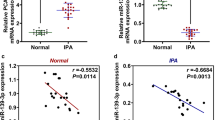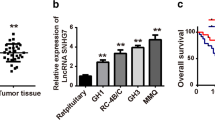Abstract
The purpose of this study was to investigate the expression of microRNA-106b (miR-106b) and phosphatase and tensin homolog deleted on chromosome 10 (PTEN) in pituitary tumor and to confirm whether miR-106b promotes proliferation and invasion of pituitary tumor cells through the PI3K/AKT signaling pathway by targeted regulation of PTEN expression, and thereby to find new targets for the treatment of pituitary tumor. Fifty-five cases of pituitary tumor tissue samples were collected, including 29 cases of invasive pituitary tumor, non-invasive 26 cases, and 8 normal pituitaries. The expression level of miR-106b in pituitary tumor tissue was detected by quantitative real-time PCR, and the expression of PTEN protein was detected by immunohistochemistry. PTEN 3′-untranslated region (UTR) luciferase vector was constructed, and dual-luciferase reporter gene assay was employed to examine the effect of miR-106b on PTEN 3′-UTR luciferase activity. AtT-20 cells were transfected with miR-106b mimics, miR-106b inhibitor, PTEN expression plasmid, and miR-106b mimics + PTEN expression plasmid respectively, and the changes in cellular proliferation and invasion were observed via MTT method and transwell assay respectively. PTEN messenger RNA (mRNA) expression was determined by quantitative real-time PCR, and western blotting was performed to detect the expression of PTEN, PI3K, AKT, and pAKT. miR-106b showed up-regulation in invasive pituitary tumor tissue: the expression level was significantly up-regulated compared with normal tissues and the non-invasive pituitary tumor tissue (P < 0.05). The positive rate of PTEN protein expression in invasive pituitary tumor tissues was significantly lower than in normal and non-invasive tissues (P < 0.01). Dual-luciferase reporter gene assay showed that miR-106b could bind to the 3ʹ-UTR of PTEN specifically and significantly inhibited the luciferase activity, cutting the 46 % (P < 0.01). Down-regulation of miR-106b or up-regulation of PTEN could suppress cell proliferation and invasion of AtT-20 cells, and PTEN expression plasmid could partially simulate the function of miR-106b. Expression of PTEN mRNA and protein decreased significantly in AtT-20 cells overexpressing miR-106b. The expression levels of PI3K and p-AKT were significantly inhibited by miR-106b inhibitor and increased by miR-106b mimics. The expression of miR-106b showed up-regulation in pituitary tumor tissues, while the protein expression of PTEN presented opposite results. The findings of this study further demonstrated that miR-106b as an oncogene regulated the pituitary tumor cell proliferation and invasion in vitro by directly targeting PTEN through the PI3K/AKT signaling pathway. Our study suggests that miR-106b and PTEN are likely to serve as potential diagnostic biomarkers or therapeutic targets for pituitary tumor treatment in the future.






Similar content being viewed by others
References
Fernandez A, Karavitaki N, Wass JA. Prevalence of pituitary adenomas: a community-based, cross-sectional study in Banbury (Oxfordshire, UK). Clin Endocrinol. 2010;72:377–82.
Shao S, Li X. Clinical features and analysis in 1385 Chinese patients with pituitary adenomas. J Neurosurg Sci. 2013;57:267–75.
Melmed S. Pituitary tumors. Endocrinol Metab Clin N Am. 2015;44:1–9.
Giustina A. Keep an eye on nonfunctioning pituitary adenomas. Clin Endocrinol. 2012;77:656–7.
Ezzat S, Asa SL. Mechanisms of disease: the pathogenesis of pituitary tumors. Nat Clin Pract Endocrinol Metab. 2006;2:220–30.
Jiang X, Zhang X. The molecular pathogenesis of pituitary adenomas: an update. Endocrinol Metab. 2013;28:245–54.
Li XH, Wang EL, Zhou HM, Yoshimoto K, Qian ZR. MicroRNAs in human pituitary adenomas. Int J Endocrinol. 2014;2014:435171.
Bartels CL, Tsongalis GJ. MicroRNAs: novel biomarkers for human cancer. Clin Chem. 2009;55:623–31.
Fabian MR, Sonenberg N, Filipowicz W. Regulation of mRNA translation and stability by microRNAs. Annu Rev Biochem. 2010;79:351–79.
Slaby O, Krekac D, Hrstka R, Svoboda M, Vyzula R. Involvement of microRNAs in cancer biology and possibilities of their application to diagnostic and predictive oncology. Cas Lek Cesk. 2008;147:25–31.
Ke TW, Wei PL, Yeh KT, Chen WT, Cheng YW. MiR-92a promotes cell metastasis of colorectal cancer through PTEN-mediated PI3K/AKT pathway. Ann Surg Oncol. 2015;22:2649–55.
Krol J, Loedige I, Filipowicz W. The widespread regulation of microRNA biogenesis, function and decay. Nat Rev Genet. 2010;11:597–610.
Pang JC, Kwok WK, Chen Z, Ng HK. Oncogenic role of microRNAs in brain tumors. Acta Neuropathol. 2009;117:599–611.
Leone V, Langella C, D’Angelo D, Mussnich P, Wierinckx A, Terracciano L, et al. Mir-23b and miR-130b expression is downregulated in pituitary adenomas. Mol Cell Endocrinol. 2014;390:1–7.
Renjie W, Haiqian L. MiR-132, miR-15a and miR-16 synergistically inhibit pituitary tumor cell proliferation, invasion and migration by targeting Sox5. Cancer Lett. 2015;356:568–78.
Wang Z, Humphries B, Xiao H, Jiang Y, Yang C. MicroRNA-200b suppresses arsenic-transformed cell migration by targeting protein kinase calpha and Wnt5b-protein kinase calpha positive feedback loop and inhibiting Rac1 activation. J Biol Chem. 2014;289:18373–86.
Yang TS, Yang XH, Chen X, Wang XD, Hua J, Zhou DL, et al. MicroRNA-106b in cancer-associated fibroblasts from gastric cancer promotes cell migration and invasion by targeting PTEN. FEBS Lett. 2014;588:2162–9.
Liu F, Gong J, Huang W, Wang Z, Wang M, Yang J, et al. MicroRNA-106b-5p boosts glioma tumorigensis by targeting multiple tumor suppressor genes. Oncogene. 2014;33:4813–22.
Zheng L, Zhang Y, Liu Y, Zhou M, Lu Y, Yuan L, et al. Mir-106b induces cell radioresistance via the PTEN/PI3K/AKT pathways and p21 in colorectal cancer. J Transl Med. 2015;13:252.
Yin Y, Shen WH. PTEN: a new guardian of the genome. Oncogene. 2008;27:5443–53.
Rubinfeld H, Shimon I. PI3K/AKT/mTOR and Raf/MEK/ERK signaling pathways perturbations in non-functioning pituitary adenomas. Endocrine. 2012;42:285–91.
Salmena L, Carracedo A, Pandolfi PP. Tenets of PTEN tumor suppression. Cell. 2008;133:403–14.
Moon SH, Kim DK, Cha Y, Jeon I, Song J, Park KS. PI3K/AKT and STAT3 signaling regulated by PTEN control of the cancer stem cell population, proliferation and senescence in a glioblastoma cell line. Int J Oncol. 2013;42:921–8.
Liao C, Chen W, Fan X, Jiang X, Qiu L, Chen C, et al. MicroRNA-200c inhibits apoptosis in pituitary adenoma cells by targeting the PTEN/AKT signaling pathway. Oncol Res. 2013;21:129–36.
Li KK, Xia T, Ma FM, Zhang R, Mao Y, Wang Y, et al. MiR-106b is overexpressed in medulloblastomas and interacts directly with PTEN. Neuropathol Appl Neurobiol. 2015;41:145–64.
Monsalves E, Juraschka K, Tateno T, Agnihotri S, Asa SL, Ezzat S, et al. The PI3K/AKT/mTOR pathway in the pathophysiology and treatment of pituitary adenomas. Endocr Relat Cancer. 2014;21:R331–44.
Trivellin G, Butz H, Delhove J, Igreja S, Chahal HS, Zivkovic V, et al. MicroRNA miR-107 is overexpressed in pituitary adenomas and inhibits the expression of aryl hydrocarbon receptor-interacting protein in vitro. Am J Phys Endocrinol Metab. 2012;303:E708–19.
Hardy J, Vezina JL. Transsphenoidal neurosurgery of intracranial neoplasm. Adv Neurol. 1976;15:261–73.
Knosp E, Steiner E, Kitz K, Matula C. Pituitary adenomas with invasion of the cavernous sinus space: a magnetic resonance imaging classification compared with surgical findings. Neurosurgery. 1993;33:610–7 .discussion 7-8
Sanchez-Tejada L, Sanchez-Ortiga R, Moreno-Perez O, Montanana CF, Niveiro M, Tritos NA, et al. Pituitary tumor transforming gene and insulin-like growth factor 1 receptor expression and immunohistochemical measurement of Ki-67 as potential prognostic markers of pituitary tumors aggressiveness. Endocrinol Nutr. 2013;60:358–67.
Zhang B, Pan X, Cobb GP, Anderson TA. MicroRNAs as oncogenes and tumor suppressors. Dev Biol. 2007;302:1–12.
Chen YZ, Li J, Zhao YX, Liu D, Wang HT, Gao Y, et al. Genetic polymorphisms in the CYP1A1 and CYP1B1 genes and susceptibility to bladder cancer: a meta-analysis. Mol Biol Rep. 2014;41:4929–40.
Zhang A, Hao J, Wang K, Huang Q, Yu K, Kang C, et al. Down-regulation of miR-106b suppresses the growth of human glioma cells. J Neuro-Oncol. 2013;112:179–89.
Li F, Liu J, Li S. MicroRNA 106b approximately 25 cluster and gastric cancer. Surg Oncol. 2013;22:e7–10.
Wang YX, Zhang XY, Zhang BF, Yang CQ, Chen XM, Gao HJ. Initial study of microrna expression profiles of colonic cancer without lymph node metastasis. J Dig Dis. 2010;11:50–4.
Smith AL, Iwanaga R, Drasin DJ, Micalizzi DS, Vartuli RL, Tan AC, et al. The miR-106b-25 cluster targets Smad7, activates TGF-beta signaling, and induces EMT and tumor initiating cell characteristics downstream of Six1 in human breast cancer. Oncogene. 2012;31:5162–71.
Hui AB, Lenarduzzi M, Krushel T, Waldron L, Pintilie M, Shi W, et al. Comprehensive microRNA profiling for head and neck squamous cell carcinomas. Clin Cancer Res. 2010;16:1129–39.
Wei Z, Zhou C, Liu M, Yao Y, Sun J, Xiao J, et al. MicroRNA involvement in a metastatic non-functioning pituitary carcinoma. Pituitary. 2015;18:710–21.
Tena-Suck ML, Ortiz-Plata A, de la Vega HA. Phosphatase and tensin homologue and pituitary tumor-transforming gene in pituitary adenomas. Clinical-pathologic and immunohistochemical analysis. Ann Diagn Pathol. 2008;12:275–82.
Fang L, Li H, Wang L, Hu J, Jin T, Wang J, et al. MicroRNA-17-5p promotes chemotherapeutic drug resistance and tumour metastasis of colorectal cancer by repressing PTEN expression. Oncotarget. 2014;5:2974–87.
Poliseno L, Salmena L, Riccardi L, Fornari A, Song MS, Hobbs RM, et al. Identification of the miR-106b ∼ 25 microRNA cluster as a proto-oncogenic PTEN-targeting intron that cooperates with its host gene MCM7 in transformation. Sci Signal. 2010;3:ra29.
Acknowledgments
This work was supported by Natural Science Foundation of Xinjiang Uygur Autonomous Region (2013211A078).
Author information
Authors and Affiliations
Corresponding author
Ethics declarations
Informed consent for this study was obtained from all patients, and this study was approved by the Research Ethics Committee of the First Affiliated Hospital of Xinjiang Medical University.
Conflicts of interest
None
Electronic supplementary material
Supplementary Figure 1
The mechanistic schema associating miRNA-106b/PTEN/PIK3/AKT with proliferation and invasion of pituitary tumor cells. PTEN expressions are inhibited by targeting of miR-106b to 3′ UTR of PTEN mRNA, thereby deterring the inhibitory effects of PTEN on conversion of PIP3 to PIP2. Accumulating PIP3 would then phosphorylate AKT after its combination with PDK1 and PDK2. Subsequently, phosphorylated AKT would translocate to the nucleus, activating molecules relevant to cell migration (e.g. MMP-3, MMP9 and VEGF) and cell proliferation (e.g. GSK3β). PIP3, phosphatidylinositol 3,4,5-triphosphate; PIP2, phosphatidylinositol 4,5-bisphosphate; PDK, phosphoinositide-dependent kinase; MMP, matrix metallo proteinase; VEGF, vascular endothelial growth factor. (JPEG 584 kb)
Rights and permissions
About this article
Cite this article
Zhou, K., Zhang, T., Fan, Y. et al. MicroRNA-106b promotes pituitary tumor cell proliferation and invasion through PI3K/AKT signaling pathway by targeting PTEN. Tumor Biol. 37, 13469–13477 (2016). https://doi.org/10.1007/s13277-016-5155-2
Received:
Accepted:
Published:
Issue Date:
DOI: https://doi.org/10.1007/s13277-016-5155-2




